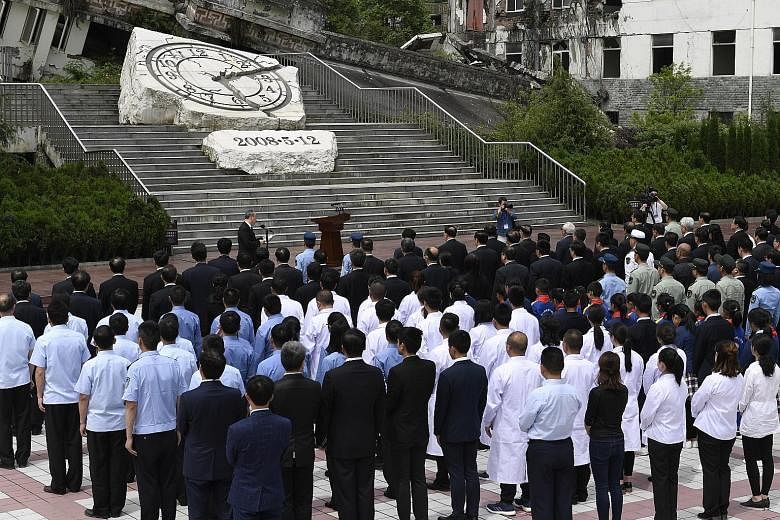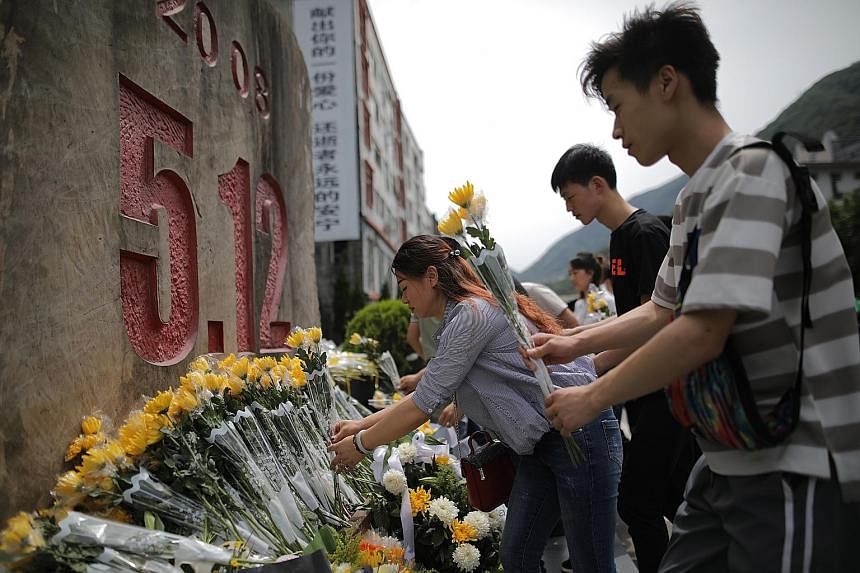BEIJING • China marked the 10th anniversary yesterday of a massive earthquake that killed tens of thousands in south-west Sichuan province and left scars on the nation that have yet to fully heal.
More than 87,000, including 5,335 school children, were left dead or missing when a 7.9-magnitude quake struck Sichuan on the afternoon of May 12, 2008 - a tragedy that triggered both raw anguish and national pride over the response.
A remembrance ceremony was held yesterday afternoon at a collapsed school in the town of Yingxiu, one of the worst-hit areas. The quake hit at 2.28pm.
President Xi Jinping sent a letter to a conference on earthquakes convened in honour of the disaster, the official Xinhua news service said.
In the text, he pledged the country would "enhance its disaster prevention capabilities" and improve scientific understanding of such events.
Editorials on the disaster filled state media yesterday, with commentators opining on how the rehabilitation of Sichuan showed the strength of China and the ruling party.
-
87,000
Number of people dead or missing after a devastating earthquake struck Sichuan on May 12, 2008.
7.9
Magnitude of the quake.
A Xinhua story explained how Mr Xi's leadership helped the region rebuild itself after the disaster - despite the fact he took office more than four years after it occurred.
Earlier this year, when President Xi visited the ruins of Wenchuan, he called for them to be used as an "important patriotic education base".
Huge donations to relief funds at the time popularised the idea of private giving, inspiring the creation of a host of new charitable organisations. But a plethora of scandals tainted the new enthusiasm for giving, with the Red Cross in particular caught up in a huge row over misdirected funds.
Today, the cities and villages that were destroyed in the quake have mostly been reconstructed, after the government poured billions into the recovery effort.
New roads, power lines and communications link the once-remote areas to the provincial capital Chengdu.
Facing public backlash amid the almost five million people left homeless in the aftermath of the Sichuan quake, China has since invested heavily to transform the way it prepares and responds to earthquakes, according to disaster experts.
"Out of the Sichuan tragedy has come huge progress," said Ms Loretta Hieber Girardet, Asia-Pacific chief for the United Nations Office for Disaster Risk Reduction.
China has "taken very strong measures to ensure that the loss of life and economic losses would not be the same in a future earthquake," she told the Thomson Reuters Foundation.
Outrage erupted across the country in 2008 after it emerged 7,000 schools were badly damaged by the quake, triggering accusations of shoddy construction, corner-cutting and possible corruption, especially as many other buildings nearby held firm. They became known as "tofu schools" in China, likening their structural instability to the soft bean curd dish.
Two of the most critical steps China has since taken were to strictly enforce building codes and improve safety at schools, said Ms Girardet.
As well as retrofitting and rebuilding many schools in quake-prone areas, China is educating children about the risks and hazards relating to quakes and what to do in a disaster.
In addition to regular school drills, Beijing has pledged more than US$31 million (S$41.4 million) over the next five years to develop seismic science and technology.
Dedicated satellites also help track and monitor hazards - be they earthquakes, storms or mudslides - 24 hours a day.
China also now has 700,000 people trained as disaster reporters, who can quickly collect information for regional and central governments on the impact of an earthquake.
A new emergency management ministry was inaugurated last month, which helps coordinate efforts to reduce risks rather than having them spread over several government ministries and departments.
"They have attempted to bring all these together under a central authority and this will allow them to both look at prevention and response to disasters in a more cohesive manner,"said Ms Girardet.
AGENCE FRANCE-PRESSE, REUTERS


